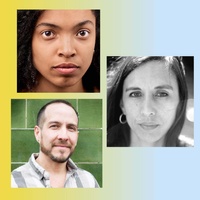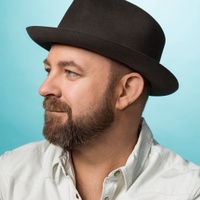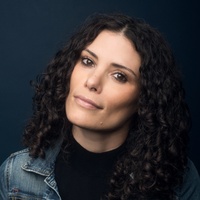As told to Gemma Seltzer, 2965 words.
Tags: Art, Inspiration, Beginnings, Multi-tasking, Politics, Process.
On creating networks as creative practice
Three artists from the UK-based arts community, Social Art Network—R.M. Sánchez-Camus, Eelyn Lee, and Hannah Place—discuss creativity as a radical act, expanding the notion of what a collective is, and personal nourishment as part of the artistic process.When did you realize that you had become an artist?
Hannah Place: It wasn’t until after university that I had confidence to admit that was what I was doing, what I wanted to do, and that what I was already acting out was an artist. I was being an artist. It was kind of like coming out and establishing that to the world. I’m going to actually name it now. I’m an artist.
Eelyn Lee: The seed was planted early. My art teacher told my mum at parent’s evening I was talented. My mum then passed that information to me. I thought, “Well, all right, I’ll do that.”
R.M. Sánchez-Camus: Similar to Eelyn, I had a mentor when I was in high school. They guided an extreme misfit and rebellious energy into a creative practice. My father was an architect, so I grew up with creativity around me. I found that with visual arts I could express this rebellion I felt inside the easiest way, with least limitations.
It’s fascinating to think about creativity as radical, as a rebellion.
Marcelo: Our work with Social Art Network, a UK-based community of artists committed to building agency for the field of art and social practice, comes from a need in the community to respond creatively to the times that we’re living in. We’ve created a way for creative practitioners working in social engagement to support each other. They volunteer their time as creative activists and help to develop an umbrella for others to link up and communicate.
As an artist, whichever medium you use, when you’re really socially engaged, you also really struggle financially, you struggle for emotional support, you struggle for peer support, you struggle for correct critical feedback that reads the aesthetics of the work that you’re trying to do, because there’s not enough language out there. All of that can be very, very isolating. It helps to realize there are lots of people out there. They can give you feedback, they can talk to you about your work, and they can talk to you about your practice. They can talk to you about how hard it is to pay rent.
Eelyn: Social practice artists are often working in isolation, even though the practice is mostly collaborative. We’re working outside of a gallery system, unsupported. We’re juggling many complex and layered relationships with many different people and stakeholders.
Solidarity and creating connections between people has such a power. That’s the thing that gains momentum, that’s the thing that encourages and attracts other people to join you.
Marcelo: And when you provide spaces for mutual support, you not only grow as an individual but you are feeding the sector. At the Social Art Summit,[a UK-wide gathering of artists, activist and community groups, co-convened by SAN in 2019], instead of just talking, we also shared our work. That was the big experiment of it.
Hannah: It seems a simple and obvious thing to say that art resists a definition, but when you’re out in public life, art kind of gets assigned this hilariously narrow definition and it impacts the way that you, as artists, think about the license that you have to engage with social environments. We’re trying to open up those restrictive definitions of art and actually help people define it for themselves again. Coming into a space with other creatives and realizing that there are other people doing things that don’t fit those definitions and questioning what you want to be.
I love the idea of it all being a big experiment. That’s life, that’s a description of life. Art, of course, can create connections. Talking of connections, you work together as a collective as Social Art Network. How did you decide that it was going to be a collective? How do you make that work? What are the tools or the systems you have in place?
Eelyn: We’re still figuring that out. Because of the nature of the practice, that it is essentially people working together, it made sense that Social Art Network should actually operate as a collective. We’re a national network but we have a core team. I think that a collective needs a core at its heart. We have meet-ups in ten places around the UK that act as mini-cores around the country. That really strengthens the network. We’re in the process of building a framework for the collective, although that framework is shifting all the time.
Hannah: As a collective, we’ve been engaging in a kind of continuous experimentation. We’re exploring different ways to work with a collective. All these different meet-ups spring up, and you find out that one actually has been running with a completely different model and it’s totally crazy and out there, and then you think, “Oh, well, can we apply that, what happens if we do that here in that other space, what happens if we have a different type of a meet-up?”
We’re in an experimentation phase and we don’t want to kill that, we don’t want to stop that, but we do need to move forward now. To learn from that. It’s a really, really interesting experience of how we maintain freedom and be explorative, but at the same time actually create a structure we can maintain.
If you’re trying to build a collective, I imagine you’d need really good administration. You would need some kind of system or tools. But, like you’re saying, as soon as you stop putting those building blocks in, you change the conditions for the conversation.
Marcelo: We are collectively-run in a way, but I wouldn’t say we are a collective. Collectives hold an identity that you’re either a part of or you’re not a part of. That’s not our ethos. It’s about how we mirror the kind of collaboration that we do in our practice, where we really push for shared authorship and a co-ownership of this. At the last gathering, the Social Art Assembly at Tate Exchange [a programme at Tate Modern relating to art and society], we talked about how to organise and it was agreed, everyone adamantly, that the last thing we wanted to do was to incorporate, become a charity, have a board of trustees and all of those things. Absolutely not.
What we are doing is re-developing and re-thinking new ways of creating and it’s in tandem with the way that socially we are moving as people, as humans within the systems of living together. We are producing things like alternative economies, alternative systems of support, and we still don’t know exactly what that is, but we’re doing it.
Eelyn: We call ourselves a community. I think the fact that we are a network is probably the most apt.
Marcelo: What we do as artists in social practice is to create spaces for people to come together where it becomes easier to have dialogue. The space that is currently politically out there is really based on the dialectic, which is about two opposing things. The dialogue is about multiple voices in the room. It’s not about necessarily finding a solution, but about a kind of egalitarianism that builds empathy and solidarity. Those are two super key phrases, and I think when I feel really inspired by Social Art Network, it comes from a real political space that is not political in any way that references the current left-right notions of politics. But political that references the polis, or the groups of people living together.
Hannah: I think there’s something really important there…in the idea of not stopping, and keeping momentum. It doesn’t really fit a lot of capitalist models where you need to have a brand and you need to refine that brand and you need to have an elevator pitch. Being a collective, there is potentially a limitation if everyone adheres to whatever brand the collective has. What’s much more useful, much more generative, and much more egalitarian, is to find a way that maybe you can’t put it across in an elevator pitch, maybe it doesn’t quite fit that model. It is much more inclusive and allows people to really bring themselves into that space—you’re not coming away with a defined idea and an agreement. You’re coming away with everyone having gained something, and given something.
That’s so interesting. So, how does being in this collaborative group of artists inform your own creativity? How has it helped you explore things or has it driven you in certain directions in your own work?
Eelyn: Apart from not feeling so isolated anymore, and feeling like you’re a part of this movement, which is really exciting, it’s given me a lot of confidence in terms of articulating my practice. One of our aims with Social Art Network is to increase critical discourse around the practice…I mean critical academic discourse, but also conversational discourse. Just through having the conversations that we’ve had already, we have started to build, change, and shift language around it.
I’m able to talk about my own practice in a different way, which feels empowering, and it feels that I am working within… almost a tradition. You’re working within an art field, that begins to have its own language and criteria for reviewing. I’ve also acknowledged that Social Art Network is part of my practice, as well. Creating networks is my practice. That has been quite a relevant revelation.
Hannah: I whole-heartedly relate to the benefit of being able to see other things as a part of the practice. I do visual work that engages socially, but then I produce events and projects which use art and engage socially. What’s quite interesting is that if I’m describing my practice as an artist to someone, and I start to describe the producing projects, the excitement and interest of, “Oh, I’m speaking to an artist,” goes away.
All of a sudden, they’re thinking, “Oh, okay, so that’s something separate, that’s not something that is creative, that’s not something that is part of your practice as an artist.” But the Social Art Network has really helped reinforce that I don’t have to separate those definitions for anyone. There are so many of us who have these different modes of our practice that engage in different ways, and sometimes that work actually is a part of your practice.
I know much of what you’re working on is solidarity and gathering people together. You’ve talked about how this creates a movement. When there is so much momentum behind what you’re doing and it’s adding interesting elements to your work as well, you do also need to pause, reflect, and look after yourselves. How do you nourish your creative sides when you aren’t working?
Marcelo: One of the things that really helps me feel grounded and emotionally nourished with the work is being able to connect to colleagues and friends—having drinks, going for a walk, having a coffee, talking about your life, talking about the human elements of what it is to be together. Because you’re spending time in our lives, which on this planet are not that long. And you’re spending some substantial amount of your time thinking, being, and participating in the life of another. And you can mask it a lot with the things that you have to do on your to-do list, but you need to take a moment and get under the skin and remember the human being.
The other thing is, for me personally, I have a really deep, physical, emotional and spiritual connection to nature. That’s where I find my resilience and my mindfulness, and my bigger picture thinking. I go to nature, and I have some woodlands where I escape and go a bit feral. I’m into scuba-diving and outdoor climbing, and I try to find spaces where I’m in the elements. And that reminds me that we are these little organisms. You know, attached to this rock floating through space. It lets all those big things in your life just suddenly fade away.
Hannah: For me, as a producer, or as an artist or as a creative or however you want to term it, there are different stages and they all look very similar. You need nourishment along the way at every stage, but there are some stages where it’s easy not to find that nourishment.
An example is the experimentation stage. Often, as an artist, when you’re experimenting, everything is happening in your mind. Your mind is having relationships with all these different things around you, and that’s great, and it’s necessary, but it can be isolating. You’re doing it on your own, and it can feel like you are alone. If you’re able to have a space where you can connect with other people who are also experimenting and coming up with wild things that they don’t even have the language to speak about yet…none of it seems to make sense, but we’re all doing it! This loops back to what Marcelo was saying about being able to sit with humans and to feel another human who is going through similar processes to you.
The question of how to nourish your creative practice when you’re not working is really interesting. I would flip that and look at it in a different way—time spent when you’re nourishing, when you’re not working, that’s still work. That’s a huge chunk of the work. It’s really important to find a nourishing flow in whatever it is that you’re doing. Even if it’s not the actual active production part of making the work, if that’s where your incubation is happening, it’s that which creates the next direction of your work.
It can be disheartening as a creative person not to be producing the work all of the time. It can feel a bit confusing, because you tend to not see those periods of time as being a part of the process of making work. But actually, it is all the process of making work. So just reframing that, I think in itself, can be a really nourishing thing.
Eelyn: As an artist you’re always ‘on’. You’re always thinking about your work, even if you’re not actively thinking. It’s within you, in your body, in your subconscious and your unconscious, in your dreams. It is a process of being active and reflective. I may be working on something on my computer, or in a sketchbook, but then I’ll go downstairs and do some washing-up. It’s when I’m doing the washing-up, sometimes an idea crystallizes. And I think okay, great. Sometimes it’s the process of walking away from it, going to do something else, which is not taking up too much brain space. That is part of the process.
Like Marcelo was saying, when you go out into nature, and you’re walking, climbing, to have a proper break from it in order to come back to it—it’s all part of the creative process, whether you define it as work or not. And then in terms of Social Art Network, sometimes when I think I might be getting bogged down with the amount of admin, which definitely is work. Then we have these monthly meet-ups in Sheffield, which I’m involved in coordinating at times. Sometimes it might feel like a drag, to have to coordinate another one. Or even just to go along to one. But then when you get there, you think, “Oh, wow, I’m so glad I came. I just feel so much better about what I was doing, in isolation.” It reminds you of the importance of just getting together and having those collective conversations.
Hannah Place uses art and creative practices as tools to address social issues in our cities. As a social artist, she produces projects which employ creativity to address problems experienced by our cities’ communities. As a visual artist, she probes the symbiotic relationship between people and the built environment. Hannah is co-organiser for Social Art Network.
Eelyn Lee is an award-winning artist and filmmaker who has exhibited across the UK including Barbican, Tate Modern, National Portrait Gallery and Whitechapel Gallery as well as internationally in Paris, Berlin, Bogotá and Toronto. Eelyn’s socially engaged practice combines collective research, devised theatre, screenwriting and filmmaking to create frameworks for ensembles of collaborators to work together. Her Chinese/English heritage motivates her interest in race, identity and ’othering’. In 2016 she co-founded Social Art Network.
R.M. Sánchez-Camus is a UK-based creative practitioner and researcher interested in collaboration, interaction, psychogeography, community wellbeing, and social systems. His arts practice incorporates community co-design into installations, walks, text, and performance. Recent work focuses on the building of support and exchange systems for artists working in social art practice. Marcelo is the co-founder of Social Art Network and recently co-convened the Social Art Summit in Sheffield leading to the world’s first Social Art Biennale. He has extensive experience in arts & health with a focus on arts as a therapeutic intervention in the dying process.
Five things:
Why Are We ‘Artists’?: 100 World Art Manifestos
The work of Assemble, the UK arts collective actively involving the public as both participant and collaborator in their work
Audrey Lorde’s essays, including The Master’s Tools Will Never Dismantle the Master’s House: “Without community there is no liberation…But community must not mean a shedding of our differences, nor the pathetic pretense that these differences do not exist…”
Sociologist Richard Sennett’s ideas exploring social life in cities
Out of Time, Out of Place: Public Art (Now), an artbook showcasing new approaches to art in public




